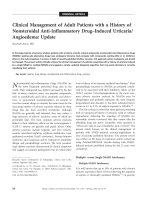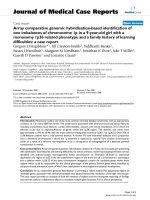02 history of WTO
Bạn đang xem bản rút gọn của tài liệu. Xem và tải ngay bản đầy đủ của tài liệu tại đây (95.88 KB, 14 trang )
SOUTH EAST ASIA
TRADE POLICY
TRAINING NETWORK
INTRODUCTION TO TRADE POLICY AND THE WTO
MODULE 7
International Trade
Institutions
History and Evolution
1
SOUTH EAST ASIA
TRADE POLICY
TRAINING NETWORK
World Trade Organization
• Created only on 1 January, 1995 by the
Marrakesh Declaration
• The youngest international organization
• Successor to the General Agreement on
Tariffs and Trade
2
SOUTH EAST ASIA
TRADE POLICY
TRAINING NETWORK
Some History
• At end of World War II, internationalism
was pursued to support peace
• To avoid conflicts based on nationalism
• Succeeded in creating:
– United Nations
– Bretton Woods Institutions
• International Monetary Fund (IMF)
• World Bank
3
SOUTH EAST ASIA
TRADE POLICY
TRAINING NETWORK
Background Cont
• Third institution was to be International
Trade Organization (ITO)
• Objective: avoid conflicts over trade and
protectionism
• Havana Charter to create ITO concluded in
March,1948
• Was never ratified because of US Congress
4
SOUTH EAST ASIA
TRADE POLICY
TRAINING NETWORK
Background Cont
• While negotiations underway, 23
participants negotiated to reduce and bind
tariffs starting in 1946
• To give early boost to liberalizing trade
and end protectionism of the 1930’s
• Was agreed to liberalize one fifth (1/5th) of
world trade and adopt some trade rules in
draft ITO Charter
5
SOUTH EAST ASIA
TRADE POLICY
TRAINING NETWORK
Background Cont
• Package called the General Agreement on
Tariffs and Trade (GATT)
• Entered into effect “provisionally” on 1
January, 1948
• “Provisionally” because Havana Charter
was still being negotiated. Those applying
GATT became known as Contracting
Parties
• Remained in force until WTO created
6
SOUTH EAST ASIA
TRADE POLICY
TRAINING NETWORK
Background Cont
• When Havana Charter failed, GATT
became only multilateral instrument
governing international trade
• Numerous negotiations were conducted
under GATT to liberalize trade
• Eight in total up to Uruguay Round which
created WTO
7
SOUTH EAST ASIA
TRADE POLICY
TRAINING NETWORK
Background Cont
• GATT continues to exist today as a part
of the WTO
• Basic principles of GATT also form basis
for WTO
8
SOUTH EAST ASIA
TRADE POLICY
TRAINING NETWORK
The General Agreement on
Tariffs and Trade (GATT)
• Multilateral trading system created under GATT
is over 50 years old
• GATT’s basic pursuit of trade liberalization
achieved through “rounds” of trade negotiations
• Early “rounds” dealt mainly with tariff reductions
• Later rounds added areas such as non-tariff
measures, antidumping, etc
9
SOUTH EAST ASIA
TRADE POLICY
TRAINING NETWORK
Results of GATT
• Exceptional growth of world trade
• Merchandize exports grew on average
6% annually.
• Total trade in 1997 was 14 times that of
1950.
• Last round (Uruguay Round) added new
areas of services and intellectual property
and created the WTO.
10
SOUTH EAST ASIA
TRADE POLICY
TRAINING NETWORK
Results Of GATT Cont
• Tariffs were reduced to such low levels
that in recessions, countries turned to
other forms of protectionism.
• Market-sharing agreements (voluntary
export restraint agreements) were used.
• Subsidies were used to encourage exports
(particularly with agriculture exports).
• Technical barriers were used for trade
protection.
11
SOUTH EAST ASIA
TRADE POLICY
TRAINING NETWORK
Results of GATT Cont
• Realities of world trade also were
changing.
• Trade was more complex and important.
• Services trade and international investment
had expanded greatly.
• Vastly increased membership with new and
different interest.
• Led to agreement to create a new expanded
agreement to encompass all these matters.
12
SOUTH EAST ASIA
TRADE POLICY
TRAINING NETWORK
Result of GATT Cont
• Uruguay Round concluded at Marrakesh
brought WTO into existence
• Also created General Agreement on Trade
in Services (GATS)
• Created Trade Related Intellectual
Property Agreement (TRIPs)
• And much more
13
SOUTH EAST ASIA
TRADE POLICY
TRAINING NETWORK
Multilateral and
Regional
Approaches
• In recent years a variety of bilateral and
regional trading arrangements have emerged
in addition to multilateral efforts at trade
liberalization.
• The GATT provides specific rules regarding
such arrangements. Similar rules exist for
services.
• But in practice these have not constrained
the growth of preferential arrangements.
14









